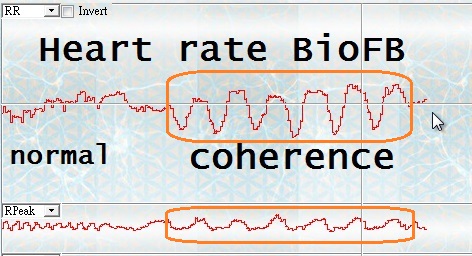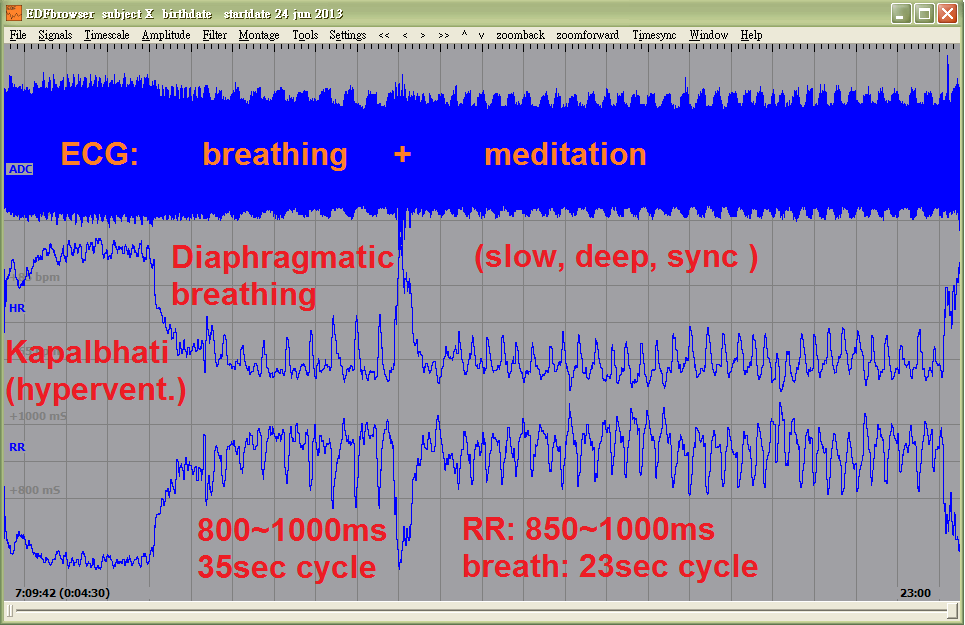Breathing is the only bodily function that is both involuntary (i.e. self regulated) and voluntary (i.e. through conscious control.) Therefore, breathing exercises are regarded as extremely important and useful in many religious, spiritual, martial art traditions, as well modern medical and relaxation techniques.
HRV from ECG sensor signal provides very useful information and can be used as bio-feedback for training breathing exercises. The inhaling (or excitation) phase of the breathing is governed by sympathetic nervous system, while the exhaling (or relaxation) phase of the breathing is governed by para-sympathetic nervous system. Inhaling phase causes faster HR and a reduction in ECG signal strength, while exhaling phase causes slower HR and an increase in ECG signal strength. Prolonged practices of breathing techniques can enable the user to gain more control over these involuntary self-regulation mechanisms.
HRV is tightly related to the workings of autonomic neuvous system (ANS). Some excerpts: "The organs (the "viscera") of our body, such as the heart, stomach and intestines, are regulated by a part of the nervous system called the autonomic nervous system (ANS). The ANS is part of the peripheral nervous system and it controls many organs and muscles within the body. In most situations, we are unaware of the workings of the ANS because it functions in an involuntary, reflexive manner. For example, we do not notice when blood vessels change size or when our heart beats faster. However, some people can be trained to control some functions of the ANS such as heart rate or blood pressure.
The ANS is most important in two situations:
1) In emergencies that cause stress and require us to "fight" or take "flight" (run away)
2) In nonemergencies that allow us to "rest" and "digest."
For more fun and insightful readings, follow these link below.
http://faculty.washington.edu/chudler/auto.html
Some interesting research work has correlated HRV with emotional states and heart-brain coherence, and proposed methods and techniques to manage and improve our own well-being.
Some excerpts: "It is well known that the respiratory rhythm modulates the pattern of the heart rhythm. This breath-related modulation of the heart rhythm is called respiratory sinus arrhythmia (RSA). RSA reflects the complex interaction of central respiratory drive, autonomic afferent signals, efferent outflow from the brain stem, and respiratory mechanics within the thorax. The phenomenon is dependent on the frequency and amplitude of respiration as well as on the underlying autonomic state of the organism. Since we have conscious control over our breathing, cognitively-directed breathing exercises can be used to impose a breathing rhythm on the heart rhythms. Thus, when we breathe at a slow, rhythmic rate (five seconds in and then five seconds out), we can facilitate coherence and entrainment. However, we do not normally think about our breathing. It is automatic; our breathing depth and rate varies without our conscious awareness due to changes in the inputs to the respiratory centers in the brain stem that control respiration."
You may also do Google search yourself, or follow the link below for more free information. such as:
http://www.heartmath.org/research/science-of-the-heart/introduction.html
the following link provides useful ECG patterns with explanations:
https://monitortech.org/rhythm-strip-practice.html
Learn how to synchronize between your brain and your heart in GetStart: BioFeedback video tutorial.
The bio-sensor tool allows us to visualize our internal (involuntary) HR rhythm. When our conscious (brain) control is carefully synchronized to our internal HR (heart) rhythm, we can achieve brain-heart coherence state within minutes of practices, producing much greater HRV than normally possible, effectively giving our heart a nice, relaxing massage. The actual technique is very simple: watch the natural (internal) heart beat interval (RR), whenever it’s turning around and start falling (i.e. heart rate goes faster), switch to inhaling (make it faster); and whenever it’s turning around to start rising (i.e. heart rate goes slower), switch to exhaling (make it slower); thereby building up an internal brain-heart resonance. The breathing will naturally go deep and slow without effort. RR change of 200msec or more within each breathing cycle can be readily achieved.

Then you can combine with some Yoga techniques and see how deep you can achieve. In the below example, start with Kapalbhati (hyperventilation, cleansing) breathing for 3 minutes, followed by deep diaphragmatic breathing for 5 minutes, building up slow, deep breathing cycle (35 sec) with RR change of 200msec or more. After that, continue on with meditation with no conscious effort in breath control, and see how your natural rhythm settles in.

